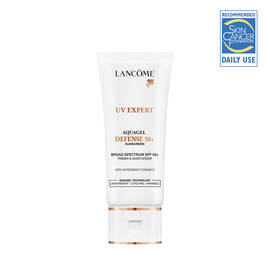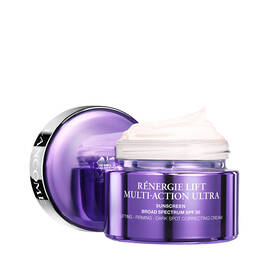How Sunscreen Helps Protect Against Premature Wrinkles, Hyperpigmentation & More
Does makeup expire? Does sunscreen truly have an effect on how skin ages? Discover how sun exposure can lead to signs of skin aging, such as wrinkles, hyperpigmentation and more.

As most know by now, sunscreen is a non-negotiable in any skincare routine. Not only is it key for lowering your risk of skin cancer, but it can also play a big role in how your skin ages and what, exactly, that looks like. (Hint: Sun spots on skin and budding wrinkles.) And while you may also know what SPF stands for and the differences between chemical and mineral sunscreens, how sun exposure damages skin is still more of a mystery. Here’s a closer look at how sunlight can affect everything from your skin barrier to eye wrinkles — and what you can do about it.
How sun exposure affects your skin
Anyone who’s ever gotten a sunburn knows that too much sun isn’t good for your skin. But while a sunburn comes with a few days of redness and discomfort, there’s more going on than the eye can see.
First, sun exposure has been found to impact the skin barrier1. The skin barrier is in charge of keeping out aggressors, be they harmful bacteria or air pollution, and sealing in good things, such as moisture. Recent research shows that sun exposure can impair healthy function of the skin barrier, leading to inflammation and moisture loss. If your skin feels dry and rough after a day in the sun, that might be why.
Then, there’s the matter of oxidative stress. Sun exposure generates free radicals, which are unstable molecules that damage skin cells in their effort to become stable2. When there are more free radicals than antioxidants — which are known for their ability to neutralize these molecules — the imbalance is known as oxidative stress. And oxidative stress on your skin can have some very visible consequences.
Why sun exposure leads to wrinkles, sun spots, and skin discoloration
Oxidative stress is like a Pandora’s Box of skin concerns. It plays a role in everything from premature signs of aging, such as deep wrinkles, hyperpigmentation and aptly named sun spots on skin, to conditions like acne and atopic dermatitis — not to mention skin cancer3.
In terms of skin aging, free radicals contribute to the breakdown of collagen and elastin4. At the same time, they can amp up inflammation in the skin. Not surprisingly, one study found that sun exposure accounts for 80% of the visible signs of aging on the face5.
That said, skin tone does impact how, exactly, this sun damage manifests in aging skin. A study found that in those with fairer skin, it tends to be a combination of skin discoloration, such as sun spots and blotchy skin, and deep wrinkles6. Those with darker skin, which has more melanin (a.k.a. skin pigment), have some protection against these effects, though it’s not enough to eschew sunscreen; research shows that melanin in skin offers, at most, SPF 47. (For comparison, the American Academy of Dermatology recommends a bare minimum of sunscreen with SPF 158.) That said, they’re also more predisposed to hyperpigmentation, such as dark spots or uneven skin tone, with age9 — and, yes, also at risk for skin cancer.
Why sunscreen for face is so important year-round
Beyond the signs of aging skin, sunscreen is important for your overall health. According to the Skin Cancer Foundation, one in five Americans will develop skin cancer by the time they’re 70 years old. And every hour, more than two people die of skin cancer10.
Sunscreen isn’t just for beach days, either. UVB rays, which are responsible for sunburns, tend to fluctuate in intensity during the day — for instance, they’re usually strongest at noon. UVA rays, on the other hand, lead to premature skin aging; they can penetrate windows and clouds alike, and are at the same strength year-round11. So, the damage from UVA rays is the same on a cloudy winter day as it is on a sunny summer day.
Sunscreen, for its part, not only slows and prevents sun damage, but has been shown to actually reverse its effects12. That’s why UV Expert Sunscreen SPF 50 should be a given in your morning skincare routine, 365 days a year. This sunscreen for face and neck doubles as a primer, offers broad-spectrum protection (meaning it defends against both UVA and UVB rays) and is oil-free, making it a great sunscreen for oily skin. Unlike some heavy sunscreen formulas, this one has a cooling, lightweight texture and sinks in quickly.
For days when you’ll be indoors — but outside for a bit or near a window, which still leaves you vulnerable to UVA rays — a face moisturizer with SPF will do the trick. Rénergie Lift Multi-Action Ultra Face Cream with SPF 30 is an anti-aging cream to offer sun protection, but it also helps visibly reduce the appearance of skin discoloration, such as dark spots on skin, and addresses signs of aging linked to collagen loss, such as wrinkles and loose skin. Apply it 15 minutes before going outdoors, and don’t forget to cover your ears and neck.
Another option? Try a tinted moisturizer with SPF, which merges makeup and skincare for a one-and-done application. Skin Feels Good Tinted Moisturizer with SPF 23 contains antioxidant-rich moringa seed oil and hyaluronic acid, and its warm tint gives skin a no-makeup makeup look.
Whichever sunscreen you choose, consider it a worthy investment in your future self — and your skin’s health.
https://www.ncbi.nlm.nih.gov/pmc/articles/PMC3479513/
https://www.ncbi.nlm.nih.gov/pmc/articles/PMC3299230/#sec2title
https://www.ncbi.nlm.nih.gov/pmc/articles/PMC4030358/#sec1-3title
https://www.ncbi.nlm.nih.gov/pmc/articles/PMC4030358/#sec1-3title
https://www.ncbi.nlm.nih.gov/pmc/articles/PMC3790843/
https://www.ncbi.nlm.nih.gov/pmc/articles/PMC3790843/#__sec9title
https://www.ncbi.nlm.nih.gov/pmc/articles/PMC2671032/#S9title
https://www.aad.org/public/everyday-care/sun-protection/sunscreen-patients/sunscreen-faqs
https://www.ncbi.nlm.nih.gov/pmc/articles/PMC4142815/#__sec2title
https://www.skincancer.org/skin-cancer-information/skin-cancer-facts/
https://www.skincancer.org/risk-factors/uv-radiation/
https://www.aad.org/public/everyday-care/sun-protection/sun-damaged/wrinkles-sun-damage-can-be-treated




